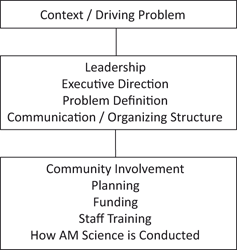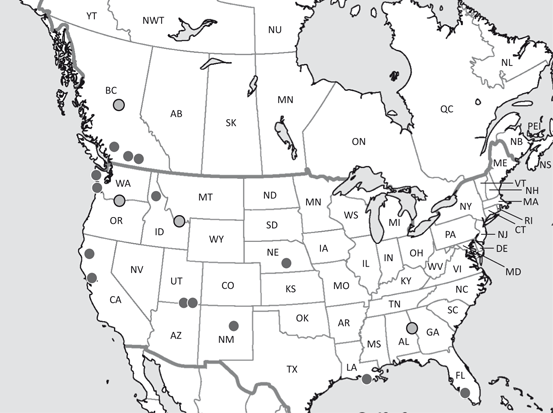Adaptive Management Today: A Practitioners’ Perspective

Fig. 10.1
Major influences on the practice of adaptive management today
While in the early years adaptive management was focused on various aspects of environmental and natural resource management, its relevance to the practice of environmental assessment (EA) was identified early on (Jones and Greig 1985) and the prevalence of adaptive management has grown rapidly in contemporary EA practice. One of the earliest references to adaptive management in the context of environmental assessment at the federal level in Canada is in the 1997 Panel Report of the EKATI Diamond Mine in the Northwest Territories (Olszynski 2010). Adaptive management was formally introduced into the Canadian Environmental Assessment Act in 2003, which focused on its use during follow-up programs for improving the quality of future assessments. Adaptive management was subsequently featured in Canadian Environmental Assessment Agency reviews and court decisions, but it was neither consistently used nor characterized, reflecting confusion about how to apply adaptive management in the context of environmental assessment, consistent with our own impressions gained through requests to critically review adaptive management plans or strategies for various development projects. The Canadian Environmental Assessment Agency released a policy statement in 2009 (CEAA 2009) which clarifies the use of adaptive management in follow-up monitoring and evaluation programs. However, EA regulators to date have had little control over what actually occurs after an EA decision has been made (a new Canadian Environmental Assessment Act (2012) includes enforcement measures for mitigations, but it is too soon to know how this will change things in practice).
The regulatory power for monitoring, evaluation and adaptation of projects after the EA decision lies within permitting agencies, and adaptive management in this context is a relatively new application that is garnering considerable interest. The Wek’èezhìi Land and Water Board in Canada’s Northwest Territories is exploring how to use adaptive management in their issuance of land use permits and water licenses, towards better environmental protection, more focused requests for monitoring from proponents, and more meaningful and informative monitoring results. They drafted a response framework for aquatic effects monitoring which involves 3 action levels (low, moderate, and high) corresponding to increasing levels of environmental change, with each level having a corresponding management response (Racher et al. 2010). Adaptive management in a similar regulatory context is also being used in water use planning to iteratively revise dam operations in British Columbia (Gregory et al. 2006) and on the Columbia River (Federal Columbia River Power System 2009), and to respond to potential impacts from California’s greenhouse gas cap-and-trade regulation (California EPA 2011).
Characterizing Adaptive Management: Three Main Dimensions
Just as examining a patient’s history and lifestyle is a fundamental part of a medical doctor’s diagnosis and treatment, we believe that characterizing the attributes of a potential adaptive management application can be helpful for pinpointing likely challenges and finding appropriate problem-solving strategies, including a decision about whether or not to apply adaptive management. At the highest conceptual level we see three dimensions to the application of adaptive management (Fig. 10.2): one pertaining to the nature of the practice, one pertaining to the nature of the problem, and one pertaining to the social/organizational environment in which adaptive management is being practiced. For each of these dimensions we describe the set of attributes or characteristics that would place adaptive management within the bulls-eye, “true adaptive management” centre sphere, with carefully designed and well monitored management experiments. As characteristics of an adaptive management application move away from the centre, they start to morph into what we call “pretend adaptive management”, or applications that share some recognizable attributes of adaptive management but lack the rigour that gives adaptive management its learning power.

Fig. 10.2
Locations of selected adaptive management projects on aquatic ecosystem management in North America. The lighter grey circles indicate projects with multiple geographic locations
Dimension 1: Characteristics of the Practice
The term ‘adaptive management’ is widely used and becoming increasingly ubiquitous in environmental management spheres. Unfortunately it has been broadly misused to the point of becoming a “plastic word”—applied in so many different circumstances that its meaning has been diluted and distorted, resulting in confusion at best, and at worst a false sense of security among those assuming that entrenching it in policy will solve their problems (Poerksen 1995). We have observed that much of the discussion of adaptive management, either by policy-makers or by purported practitioners, falls outside of what we would consider “true adaptive management.” In many cases this stems from false beliefs that adaptive management is the same as adapting to serendipitous learning, the mistaken notion that adaptive management is what managers have been doing all along, false hopes that it is a magic bullet for growing uncertainty, or simply a lack of understanding about what adaptive management is. Some misunderstandings are probably facilitated by the simplicity of its name. While the idea of adaptive management is simple and elegant, the practice of adaptive management can be complex. We believe that “true adaptive management” includes all of the steps and elements shown in Table 10.1. This list of elements was initially crafted with leading practitioners in the field of forest management and honed through subsequent work on adaptive management projects in the fields of water management and ecosystem restoration . In some instances it may be difficult or unnecessary to undertake absolutely all of the listed elements, but each plays an important role; leaving any elements out should be done with full knowledge and explicit consideration of the implications.
Different practitioners , even those practicing “true” adaptive management, likely all use slightly different definitions of adaptive management. We therefore find it useful in our adaptive management discussions, practice and training to use the concept of an adaptive management “definition space”. Applications of adaptive management at the most rigorous end of the definition space would ideally include all of the elements in Table 10.1. As applications of adaptive management move further away from this they lose structure and rigor, and at some point they leave the adaptive management definition space (“true adaptive management”) and move into some other learning paradigm that may bear a resemblance to adaptive management or share some of its characteristics and elements, but cannot really be considered adaptive management anymore. Rather than debate the conceptual location of the boundary between adaptive management and other approaches, we find it more productive to acknowledge that the definition space exists, that it may be larger in the minds of some practitioners than others, and that it is probably expanding as domains of practice broaden, and to try to work as close to the rigorous end of it as possible. The bottom line: rigor decreases as elements are ignored or abandoned, and at some point the application moves out of the adaptive management definition space to some other less rigorous approach to learning the effects of management actions (Table 10.1).
Table 10.1
Ideal elements of adaptive management at the most rigorous end of the adaptive management “definition space” (Murray et al. 2011)
AM steps | Ideal elements within each step |
|---|---|
Step 1. Assess and define the problem | a. Clearly state management goals and objectives |
b. Review existing information to identify critical uncertainties and management questions | |
c. Build conceptual models | |
d. Articulate hypotheses to be tested | |
e. Explore alternative management actions (experimental ‘treatments’) | |
f. Identify measurable indicators | |
g. Identify spatial and temporal bounds | |
h. Explicitly state assumptions | |
i. State up front how what is learned will be used | |
j. Involve stakeholders, scientists, and managers | |
Step 2. Design | a. Use active adaptive management b. When and where possible, include contrasts, replications, controls c. Obtain statistical advice, building on analyses of existing data d. Predict expected outcomes and level of risk involved e. Consider next steps under alternative outcomes f. Develop a data management plan g. Develop a monitoring plan h. Develop a formal adaptive management plan for all of the remaining steps i. Peer-review (internal, external) the design j. Obtain multi-year budget commitments k. Involve stakeholders |
Step 3. Implement | a. Implement contrasting treatments b. Implement as designed (or document unavoidable changes) c. Monitor the implementation |
Step 4. Monitor | a. Implement the monitoring plan as it was designed b. Undertake baseline (‘before’) monitoring c. Undertake effectiveness and validation monitoring |
Step 5. Evaluate results | a. Compare monitoring results against objectives b. Compare monitoring results against assumptions, critical uncertainties, and hypotheses c. Compare actual results against model predictions d. Receive statistical or analysis advice e. Have data analysis keep up with data generation from monitoring activities |
Step 6. Adjust hypotheses, conceptual models, and management | a. Meaningful learning occurred, and was documented b. Communicate this to decision makers and others c. Actions or instruments changed based on what was learned |
Dimension 2: Characteristics of the Problem
The characteristics of the problem include sub-dimensions of scale, reversibility, and the type of uncertainty being addressed. A critical requirement for adaptive management is contrast over space and time. The spatial scale of an adaptive management application depends on the geographic extent of the particular management uncertainties and objectives in question, and the area needed to adequately test hypotheses using experimental design elements of replicates, contrasts, and ‘controls’ or reference sites. Implementing adaptive management at large spatial scales increases the breadth and complexity of all of the steps: there will likely be more stakeholders, perspectives and conflicting values; broader objectives that may be difficult to quantify at larger scales; more uncertainties to examine and sequence; more management entities to align; more landowners to engage; less ability to find appropriate controls and replicates at the scale of large management actions (e.g., river basins); and more nested treatment sites to design, implement, monitor and evaluate. The temporal scale of an adaptive management application depends on several factors: how long it will take for the system to respond to the treatments; how long it will take to be able to detect this response given the monitoring resources and design; and the natural temporal variability in the system. If there is high year-to-year variability in key system drivers (e.g., precipitation, ocean conditions) or attributes (e.g., species abundance or survival), it will take longer to implement an experimental design that compares the outcomes of contrasting management actions, and controls for confounding factors, across these variable conditions. Adaptive management will also take longer if contrasting treatments cannot be done spatially and must therefore be done sequentially. For example, implementing different spring flow treatments in a single river system will need to be done across multiple years, since there is only one river and spatially concurrent contrasting treatments are not possible. If this single river system also has high natural variability, detecting the signal of management effects within the noise of natural variation may require even longer durations of monitoring and evaluation (Alexander et al. 2006).